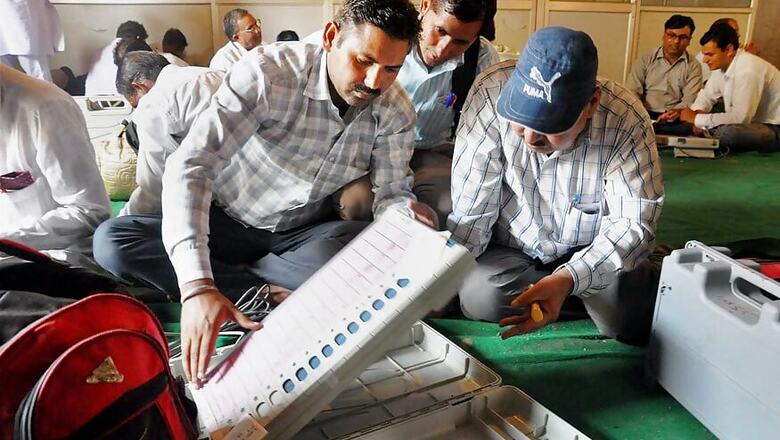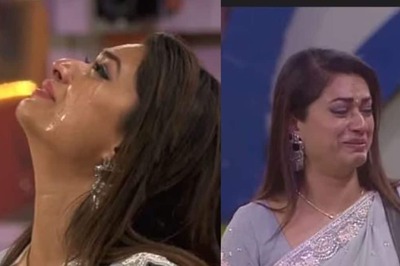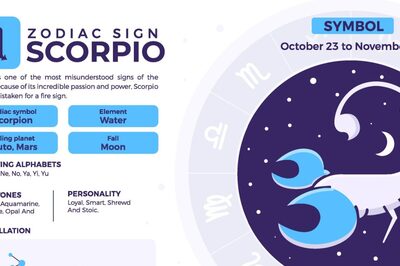
views
New Delhi: Will holding simultaneous elections, by any means, tinker with democracy, the basic structure of the Constitution or the federal polity of the country?
This one question led the 21st Law Commission of India to present a 160-page draft report on simultaneous elections, where it has stated that the “time has come for India to revert to simultaneous elections in greater national interest”.
The commission has stated that simultaneous polls to Lok Sabha and state assemblies (except in J&K) will save public money and ensure better implementation of government policies. But Article 172 of the Constitution requires to be amended for the same.
The commission has, however, refrained from submitting a final report as reported earlier by News18. It believes that more deliberations and research would be needed before a final report can be tabled before the government.
In July this year, the commission had met several political parties to discuss the feasibility of joint polls. It has now noted that parties have expressed concern regarding hung assembly and other aspects and believes it would adversely impact joint polls. But the law panel states that it thinks otherwise.
“Most of the participants in the consultations raised the issue that holding simultaneous elections will adversely affect the above three concepts. However, none could explain as to how and in what manner these principles would be violated, to the satisfaction of the Commission,” reads the report.
The commission noted that there were apprehensions that the model code of conduct would prove problematic in case of simultaneous elections but believes such a situation can be averted. “The Government(s) may defer such schemes till the completion of the election process, thus slowing down the pace of their ambitious work,” notes the report.
Another contention of the Opposition that the commission has brushed aside is that the “ruling party will become autocratic without any checks and balances” and has stated that with a longer tenure, “a government can only better dictate terms to achieve the developmental works”.
With regard to past elections where simultaneous polls with some states were held, the commission had proven the efficacy of joint polls.
“In Indian context if we reflect back on the elections held in the past in various States, simultaneous elections have led to increased voter turnout in 1999, for Karnataka, Maharashtra and Andhra Pradesh, by nearly 11.5%. In 1977, simultaneous elections in Kerala with national elections augmented voter turnout by nearly 20%. Similarly, simultaneous elections in north-eastern states with national elections, have been empirically shown to boost voter turnout by 21% in Arunachal Pradesh and 17% in Assam,” says the report.
As reported by News18, the question of hung assembly had proven to be a roadblock in the finalisation of a report by the commission on One Nation, One Poll.
Hung assembly is a situation where a single political party or a pre-poll alliance does not have enough elected members to secure an overall majority.
However, if a member of the House/assembly seeks support from other political parties to form a government, then their respective political party can issue whips, barring support to such a member, and if they go against the party whip to support his or her endeavour, it would render them disqualified under paragraph 2(1) (b) of the Tenth Schedule.
This tenth schedule and hung assembly is what the commission believes need to be dealt with through more deliberations and research.
However, on one question, the commission still remains undecided. “The suggestions given by various Committees and Commissions to deal with the situation of hung Parliament or Assembly, where no political party has majority to form a Government, propose that the Prime Minister or Chief Minister may be appointed or selected in the same manner as a Speaker of the House or Assembly is elected. Will it be possible? If so, will it be in consonance and in conformity with the Tenth Schedule to the Constitution?” questions the report.
The commission has noted that if all alternate modes of elections to give simultaneous polls a boost fail, then holding mid-term elections would be the only alternative. “In case of failure of the aforesaid options, the only alternative will be that of mid-term elections,” notes the report.
So far as state assemblies are concerned, under the Constitution, President’s Rule can be imposed for a maximum period of three years under Clause (4) of Article 356 of the Constitution, subject to various limitations specified in the said Article.
But in the case of the Union, the option of President’s Rule is not available and therefore, the only recourse left will be to have mid-term elections.
The option that the commission has devised is that elections are held twice a year so that all states can go to polls together.
As per the report, once it is decided to synchronise the elections of 13 states along with the elections to the House of the People in 2019 and the rest of the 16 states and one Union Territory with the legislature in 2021, elections will be synchronised in such a manner that they are held only twice in five years.
This means elections to the Lok Sabha and 12 states and one Union Territory with legislature in mid-2024 and elections to 16 states and one Union Territory with legislature in the end of 2026.
The commission has noted that if curtailment of a term is concerned then “unless sooner dissolved” as provision in the Constitution opens the door to holding joint polls without constitutional amendments too.
“For simultaneous elections, the term of the House of the People or State Legislative Assemblies may require curtailment or extension/enhancement. So far as curtailment of the term is concerned, the Constitution does provide an option for doing so voluntarily by virtue of the phrase, unless sooner dissolved‟ and not by operation of law; but as far as the enhancement of the term is concerned, that will be possible only with an amendment to the Constitution,” says the draft report.
However, the Justice BS Chauhan-led commission has stated that it is “aware of the fact that holding simultaneous elections is not possible within the existing framework of the Constitution”.
The commission also notes that the Election Commission too would need to make some administration and logistical changes to realise the project of One Nation, One Poll.
The Election Commission of India estimates that there will be about 10, 60,000 polling stations for the elections to the House of the People in 2019. It has further informed the commission that as of now, there is a shortfall of about 12.9 lakh Ballot Units, 9.4 lakh Control Units and about 12.3 lakh VVPATs, if simultaneous elections are to be held.
However the commission has mooted an idea that EVMs with more shelf life will lead to smoother joint elections. “EVMs (BU, CU and VVPAT) are re-usable with a shelf life of about 15 years and so, conducting subsequent elections will become smoother. Hence, from financial considerations, implementing simultaneous elections seem to be not only feasible but also desirable and will result in reduction of enormous costs involved in separate elections,” notes the draft report.
The commission has also recommended that to ensure smooth, peaceful and impartial polls, EC would need services of a significant number of polling officials from government organisations.
However, the commission has noted that simultaneous elections would be beneficial for the country as it would “save public money, help reduce the burden on administrative set up and security forces, ensure better implementation of government policies on time and the administrative machinery of the country will be continuously engaged in developmental activities rather than in electioneering”.




















Comments
0 comment